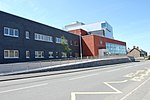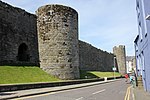Ysgol Syr Hugh Owen
Ysgol Syr Hugh Owen is a bilingual comprehensive secondary school for pupils aged 11–18. The school is situated in Caernarfon, Gwynedd, Wales. The school was established in 1894, the first to be built under the Welsh Intermediate Education Act 1889, which was heavily influenced by the educator Sir Hugh Owen, after whom the school was named. As of 2022, there were 937 pupils enrolled at the school. Its current headteacher is Paul Mathews Jones. It serves the town of Caernarfon and the nearby villages, which include; Bontnewydd, Caeathro, Y Felinheli, Llandwrog, Rhosgadfan and Rhostryfan.Welsh is the school's main language of communication and administration. All subjects, except Welsh and English, are taught to all pupils using both languages. According to the latest Estyn report, 90% of pupils speak Welsh with their families and 92% are fluent in the language. The school claims that 98% of pupils were fluent in Welsh in 2016.There is also a sixth form, which enables students to stay at the school for a further two years instead of having to transfer to college.
Excerpt from the Wikipedia article Ysgol Syr Hugh Owen (License: CC BY-SA 3.0, Authors).Ysgol Syr Hugh Owen
Llwyn Ceirios,
Geographical coordinates (GPS) Address Phone number External links Nearby Places Show on map
Geographical coordinates (GPS)
| Latitude | Longitude |
|---|---|
| N 53.1462 ° | E -4.2633 ° |
Address
Ysgol Syr Hugh Owen
Llwyn Ceirios
LL55 1HW , Caernarfon
Wales, United Kingdom
Open on Google Maps








